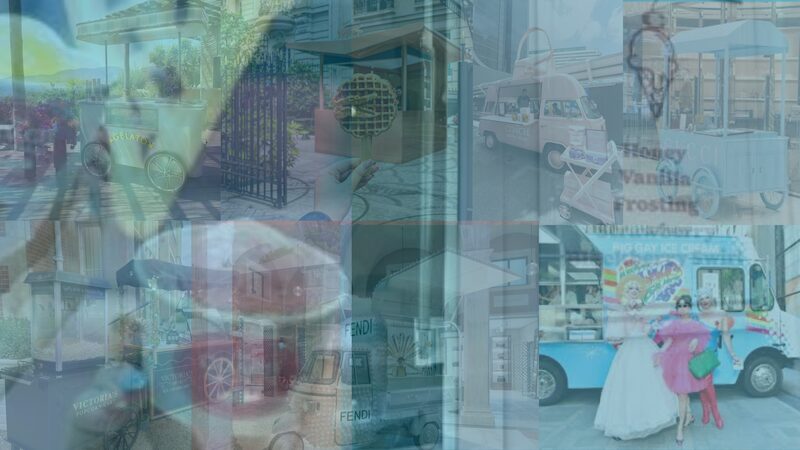
In recent summers, an oddly charming yet curious trend has emerged across global luxury hubs—from Paris to Seoul, Milan to Miami: the luxury ice cream cart. Dior does it. Gucci does it. Jacquemus lives it. On every cosmopolitan corner or tucked inside a luxury department store atrium, a brightly coloured cart rolls in, offering sorbet-hued cones and hyper-aestheticised branding. Instagram clicks. PR rolls out. But the industry asks: is this a pop-up, or just a seasonal craving disguised as strategy?
The lines between pop-up store, brand activation, and ephemeral communication are melting—faster than the gelato.
Are We Still Talking About Pop-Ups?
Pop-ups have long been a tool of retail innovation: temporary, disruptive, often immersive, and always strategic. A pop-up, in its truest form, responds to a business objective. It creates a punctuated yet meaningful interaction between the brand and its audience. It might test a market, engage a new demographic, or experiment with retail architecture.
But what happens when this “pop-up grammar” is diluted to its most decorative elements?
Luxury brands have increasingly jumped onto what could be dubbed the “ice cream cart bandwagon”—a phenomenon wherein carts, vans, or bike stalls are deployed as brand expressions. These are cute, colourful, and highly shareable. But do they qualify as pop-ups?
If a pop-up is about strategy, space, storytelling, and salience, then many of these carts fall short. They are often activations, not full retail experiments. They communicate taste—both literally and figuratively—but rarely do they convey depth, disruption, or dialogue. The ice cream is cold. The concept? Often lukewarm.
A Symptom of Pop-Up Confusion
This surge in flavourful cart-based branding reveals a broader challenge: brands are increasingly confusing communication with experience, and strategy with stunt.
Is the cart part of a pop-up—a supporting character in a larger, temporary store experience? Or is it the pop-up in itself, standing alone as a retail expression?
When the answer is unclear, the strategic gap becomes painfully visible. The cart may earn a post on Vogue’s Instagram feed, but does it shift brand perception, open a new market, or deepen emotional connection? Without these outcomes, the cart risks becoming a passing summer fling.
Why Luxury Brands Must Recalibrate
In the context of luxury, where meaning, memory, and rarity define value, the misuse of the pop-up format is more than a harmless gimmick—it’s a missed opportunity.
A true luxury pop-up is not just temporary—it’s temporarily transformative. It does not merely sell products; it stages brand worlds. It doesn’t just hand out ice cream—it communicates craft, heritage, and desire through every cone and corner.
When a cart is conceived as a tactic, not a strategic act, the result may be visibility without impact. And in luxury, impact is everything.
Here are 5 action plans I could recommend for luxury brands navigating the current “pop-up versus activation” dilemma:
1. Reassert the Definition of Pop-Up: Brands must return to the core definition: a pop-up is a temporary commercial space designed with a clear strategic purpose—be it market testing, exclusivity, narrative immersion, or community building. Before launching a cart or stand, teams must ask: What is our goal beyond visibility? A cart might be the entry point, but unless it’s embedded within a larger journey—be it physical or digital—it is not a pop-up. It’s branding, not retail.
2. Map the Customer Journey, Not Just the Hashtag Moment: Luxury experiences must unfold, not just pop. Brands need to think beyond the cart: What happens after the ice cream is consumed? Where does the consumer go next? Is there a QR code that links to a limited collection? A scent embedded into the cone wrapper that recalls the brand’s olfactory heritage? Each ephemeral element should be part of a longer narrative. Otherwise, the memory melts faster than the product.
3. Embed the Cart Within a Transient Architecture: Rather than standalone stunts, these flavour carts should be one touchpoint within a multi-sensory, mobile boutique environment. Think of Hermès’ travelling caravans or Louis Vuitton’s nomadic showcases. The cart, in this context, is a micro-module—delivering flavour and form, but also leading consumers into the spatial grammar of the brand.
Architects, set designers, and scenographers should co-design these ephemeral elements with storytelling in mind. The cart becomes an artifact, not an accessory.
4. Design for More Than the ‘Intagrammable Moment’: In today’s media landscape, it’s easy to be seduced by virality. But virality is not vitality. True luxury pop-ups must be designed for resonance over reach. Instead of focusing on how cute the cart looks in pastel, focus on how the brand essence is transposed into the experience—is there craftsmanship in the way the ice cream is made? Does the cart reflect the textures of the brand’s latest collection? Is the server trained in brand storytelling? Each element must communicate identity.
5. Establish an Ephemeral Retail Task Force: To avoid falling into the trap of superficial execution, brands should create dedicated cross-functional teams for ephemeral retail. This team should include marketing, retail operations, design, and strategy. Its role? To ensure that every pop-up—whether an ice cream cart or an immersive concept store—meets the criteria of strategic alignment, spatial intelligence, brand coherence, and measurable KPIs. Without such a task force, pop-ups risk becoming PR-driven fragments rather than retail ecosystems.
From Ice Cream to Iconography
The luxury ice cream cart is not inherently problematic—it can delight, attract, and even spark curiosity. But when misused, it becomes a symptom of a deeper confusion: a blurring of strategic formats under the weight of seasonal trendiness.
Luxury brands must pause and ask: Are we truly popping up, or just popping in?
A cart is a charming gesture. A pop-up is a strategic statement. The difference lies not in duration, but in intention. If luxury is about meaning, then every ephemeral experience—no matter how small—must be crafted, curated, and consciously deployed. Otherwise, it’s just ice cream.




